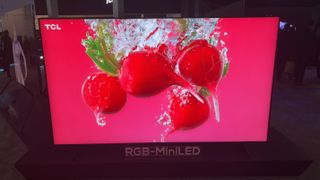CES 2025 marked the launch of two new groundbreaking OLED TVs; the Panasonic Z95B and LG OLED G5. Both use LG DIsplay’s new Four Stack OLED panel structure for a significant leap in brightness – though it means that Micro Lens Array (which both of these TVs’ predecessors utilised) has officially been phased out after just two years on the scene. Rest in peace MLA-OLED, we hardly knew ye.
While, at first, this was a shocking revelation, the more we think about it, the more it makes sense. We’re willing to bet that embuing OLED panels with millions of microscopic lenses was a fiddly process, undoubtedly costing LG Display a pretty penny to produce. Also, we recently saw Apple launch its latest iPad Pro with Tandem OLED, which appears to be in the same vain as this new TV panel. By stacking more layers of OLED together, you get higher brightness – simple.
And the higher brightness is apparent. Speaking from experience of seeing both the Z95B and G5 in person at the Vegas tech expo, the enhancement is remarkable; highlights pop and colours are striking without looking too enthusiastic. So, while MLA-OLED will be missed, and likely remembered as a short-lived yet interesting time in OLED TV history, we wish it farewell and move on to another panel technology that made its debut at CES, and has potentially sealed the fate of another well-known display technology.
Samsung and TCL unveiled brand new LED panel technologies at the show; well, technology technically as, despite both companies giving it different names, it's using the same backlighting system. Samsung is calling it RGB Micro LED (not to be confused with Micro LED, which is a completely different panel technology with a very similar name), whereas TCL calls it RGB-MiniLED. The crux is that, instead of having a blue pixel providing light with a red and green quantum dot layer overtop, there are now much smaller red, blue and green LEDs that can be controlled to a much more granular level.
It’s very early days, and we’ve been assured by Samsung and TCL that it is still a couple of years away from being implemented into a mainstream TV, but it means we could see this panel technology take the baton from QLED TVs. Quantum Dots have no place with this new panel as they are simply not required, meaning TCL’s QD-MiniLED range and Samsung’s Neo QLED range could soon be superseded.
It’s not been completely confirmed, but during a behind-closed-doors demo at the Las Vegas Convention Centre, we asked if RGB Micro LED could be the next evolutionary step for backlit TVs, to which Samsung seemed to give us an inclination that we could be on the right tracks.
Could this mean that QLED’s days are numbered? It’s possible, but considering that so many affordable sets now use quantum dot LED panels, we’re not convinced that the industry will drop it quite as brutally as it did with MLA-OLED. There are still plenty of benefits to QLED and, as is the case with nearly every new TV display technology, we’re willing to bet that the first round of TVs that use this technology will cost an absolute fortune.
That being said, these developments often trickle down into the budget sector eventually, and with TCL backing this new development, we’re intrigued to see if the company will implement it into its affordable backlit TV portfolio.
MORE:
OLED vs QLED: which is better?
What is Micro Lens Array (MLA) technology?
Read our full LG G4 OLED TV review
